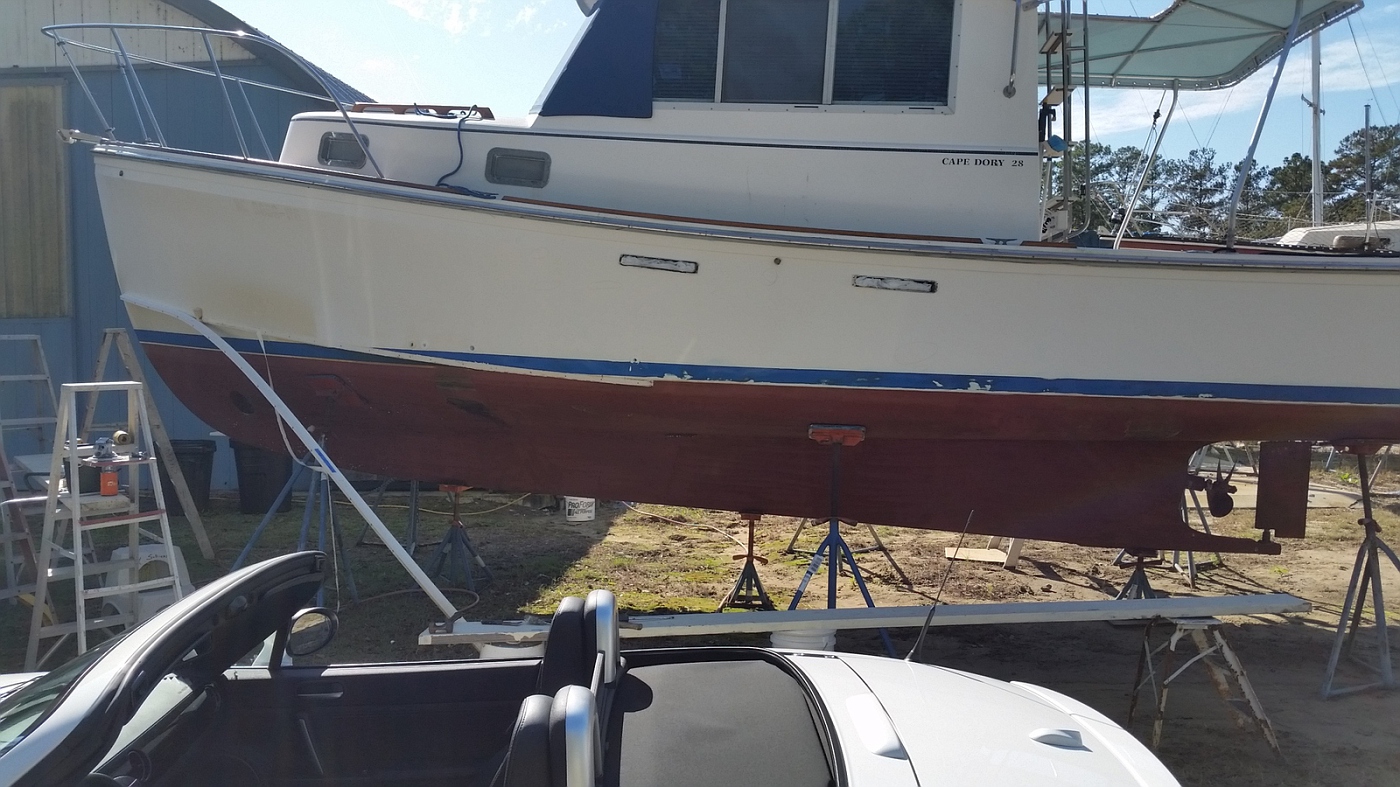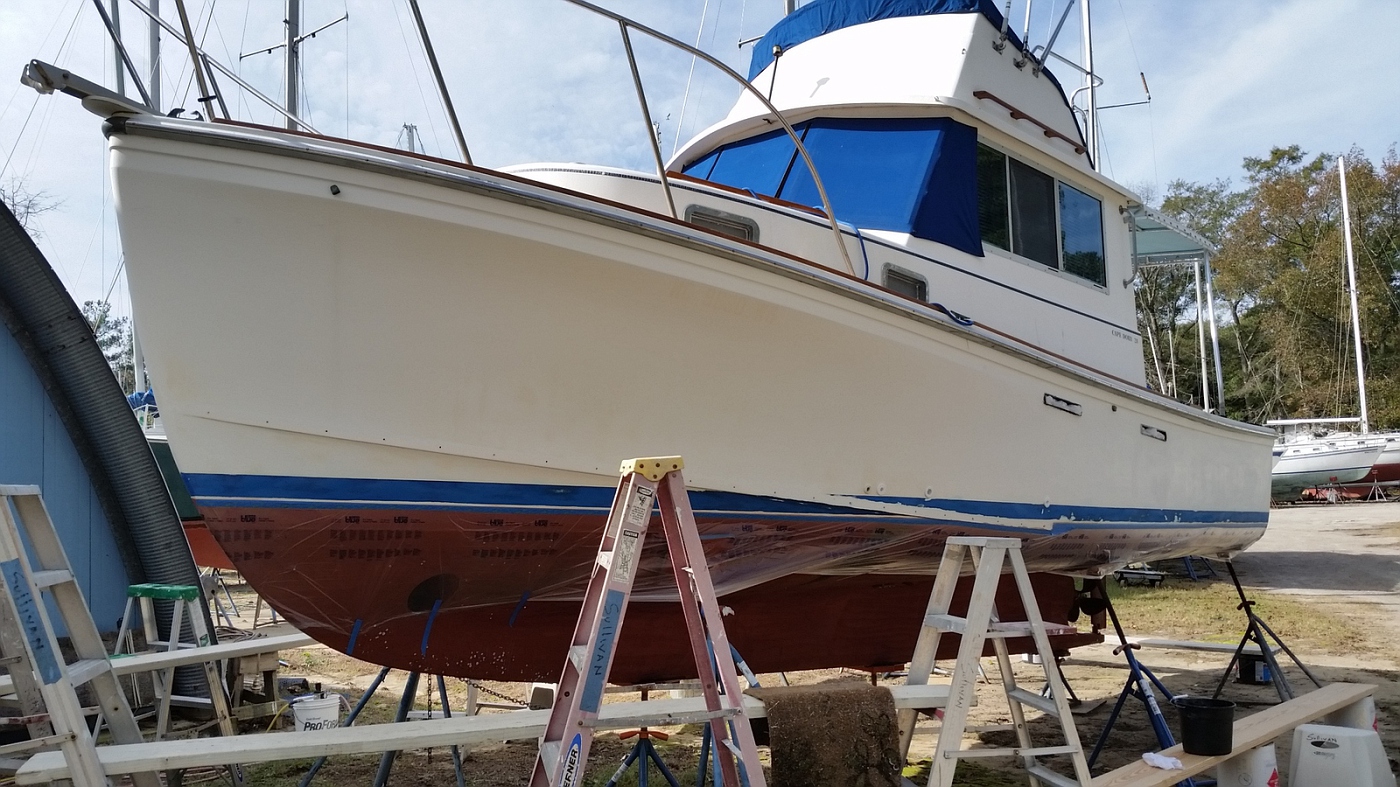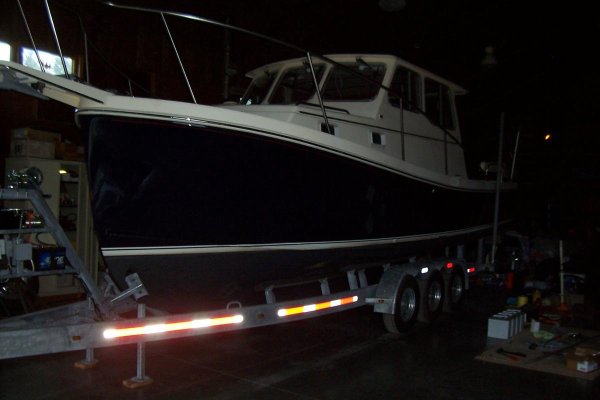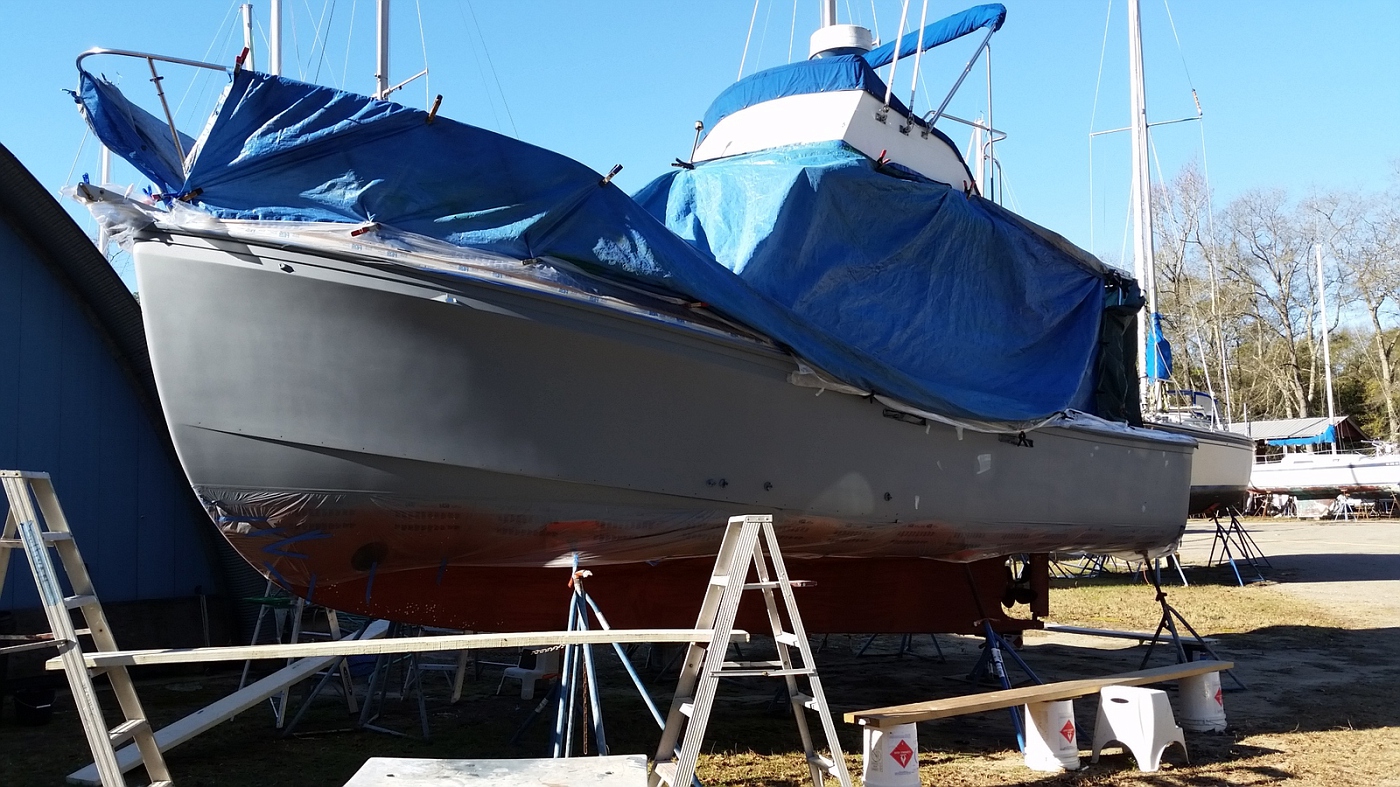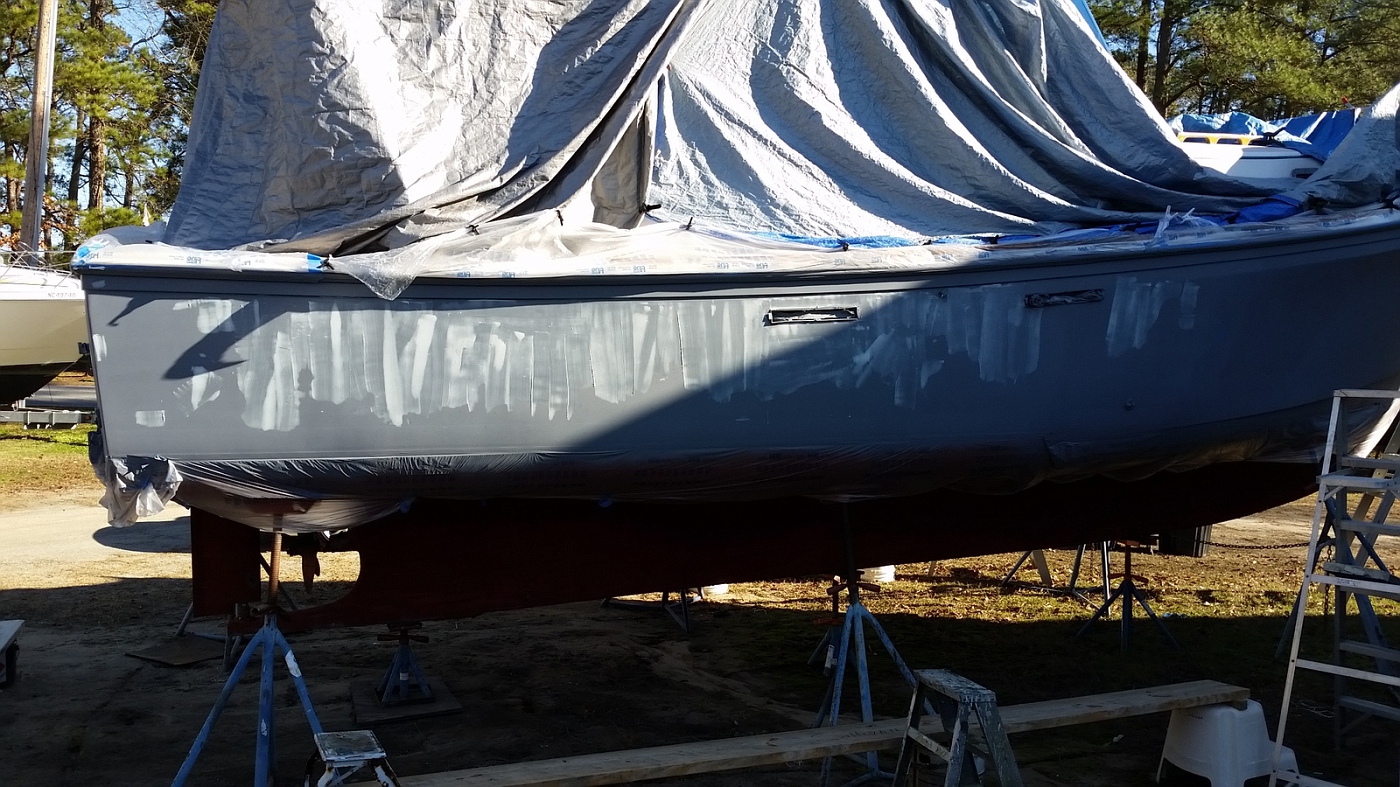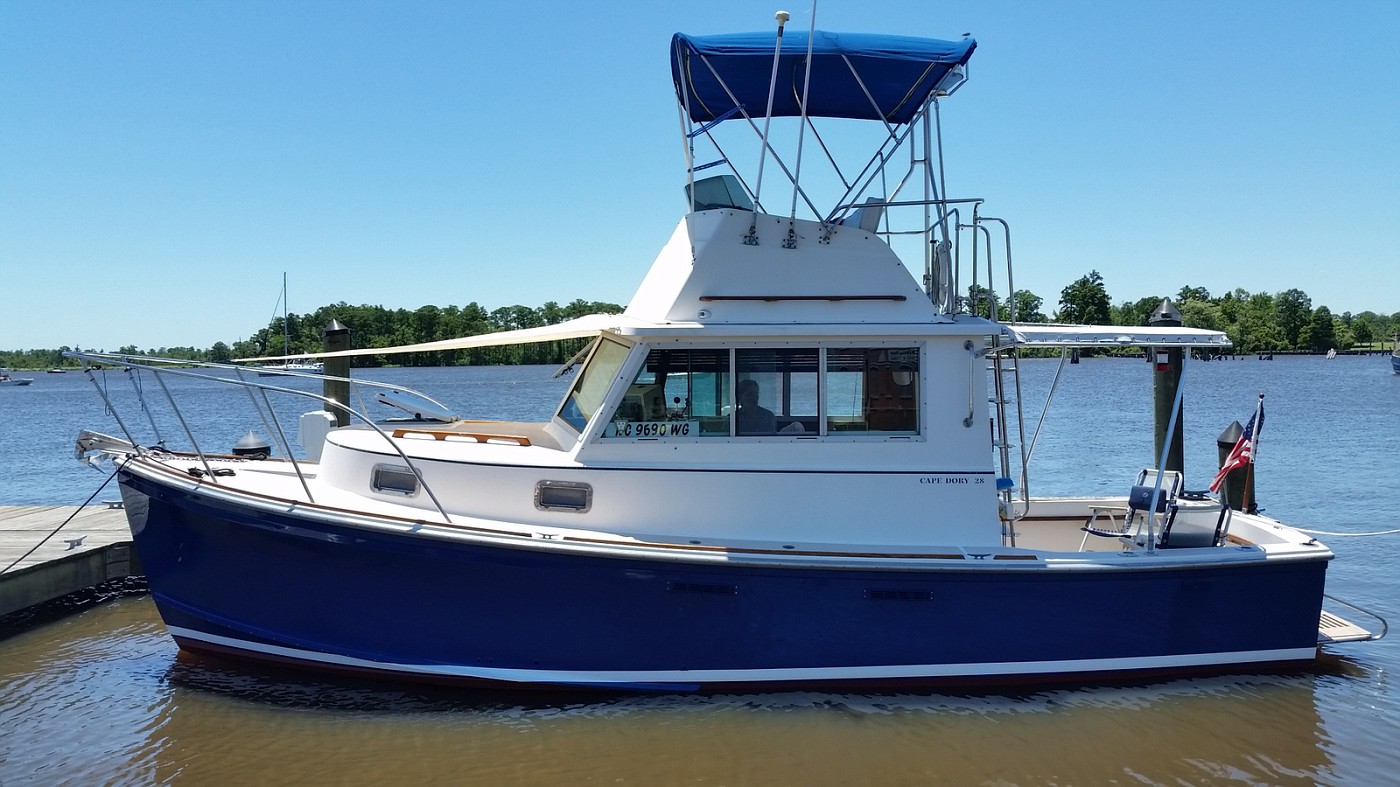You are using an out of date browser. It may not display this or other websites correctly.
You should upgrade or use an alternative browser.
You should upgrade or use an alternative browser.
Paint work....>
- Thread starter Heron
- Start date
The friendliest place on the web for anyone who enjoys boating.
If you have answers, please help by responding to the unanswered posts.
If you have answers, please help by responding to the unanswered posts.
This is exciting. It only gets better from here.
Heron
Guru
- Joined
- Nov 5, 2014
- Messages
- 1,304
- Location
- USA
- Vessel Name
- Heron (2)
- Vessel Make
- '88 Cape Dory 28 Flybridge #115
This is exciting. It only gets better from here.
Yes it is! I've talked with my paint guy several times now. He really likes the boat and is very anal in his work. I didn't expect him to remove the spray rails, but he says he can do a better job if he does and re-seals them. They are bolted into Nuts molded into the laminate, so no water intrusion issues. Nice attention to detail, albeit more work for him. That and the fact that it will be on display at my Waterfrnt dock for all to see. He knows his work will be on constant display and plans to do a perfect job as a result.
We decided not to take the boot stripe over the Rail, as it will look odd from any angle but directly from the side.....Here's the P-chop, though it shows the boot stripe over the rail...It's gonna look great!

caltexflanc
Guru
That at McCotters?
Panacea
Veteran Member
- Joined
- Aug 17, 2015
- Messages
- 88
- Location
- USA
- Vessel Name
- Panacea
- Vessel Make
- Marine Builders, Voyager 70
You're gonna be real happy when "the shiny" goes on!
BTW: I've worked with Awlgrip, Awlcraft, and Alexseal. I prefer Alexseal since its the best of both worlds, but Awlcraft is good too, just a bit "soft" for my taste and the gloss not as deep. Really, the *PREP* is everything though. Every topcoat paint out there is good in one way or another, but will look bad with poor prep. 99% of the work is prepping. Heck, they shouldn't call it "painting a boat" they should call it "prepping a boat". The shiny stuff is the fun/easy/rewarding part.
BTW: I've worked with Awlgrip, Awlcraft, and Alexseal. I prefer Alexseal since its the best of both worlds, but Awlcraft is good too, just a bit "soft" for my taste and the gloss not as deep. Really, the *PREP* is everything though. Every topcoat paint out there is good in one way or another, but will look bad with poor prep. 99% of the work is prepping. Heck, they shouldn't call it "painting a boat" they should call it "prepping a boat". The shiny stuff is the fun/easy/rewarding part.
Wow. That's fast. Are you going to be done this year?
Heron
Guru
- Joined
- Nov 5, 2014
- Messages
- 1,304
- Location
- USA
- Vessel Name
- Heron (2)
- Vessel Make
- '88 Cape Dory 28 Flybridge #115
Wow. That's fast. Are you going to be done this year?
It all depends on Temps Larry.... 75 degrees for Wedesday so maybe the prime coat will go on..Final color coat, who knows... I pulled it early to give them plenty of time to find a weather window to do the job. As nice as it's been here, I could be boating!
Heron
Guru
- Joined
- Nov 5, 2014
- Messages
- 1,304
- Location
- USA
- Vessel Name
- Heron (2)
- Vessel Make
- '88 Cape Dory 28 Flybridge #115
Will you be changing the spray rails out for Black ones or keeping the White? Done correctly the boot stripe over the rails looks nice.
Spray rails will be hull color. I've decided to not carry the boot color over the rails because they will look awkward except directly from the side the way the boot color has to be cut in. If I change my mind on this (and I may) it can be easily fixed while in the water..
Last edited:
diamondeyes
Newbie
caution awlgrip aristo blue will fade!!!!!!!!!!!
Heron
Guru
- Joined
- Nov 5, 2014
- Messages
- 1,304
- Location
- USA
- Vessel Name
- Heron (2)
- Vessel Make
- '88 Cape Dory 28 Flybridge #115
caution awlgrip aristo blue will fade!!!!!!!!!!!
Huh? Funny, my last Aristo Blue paint job never did. Looked as good 10 years after application as it did when first done.....If that's your experience, I'd blame it on a bad paint job, not the material.
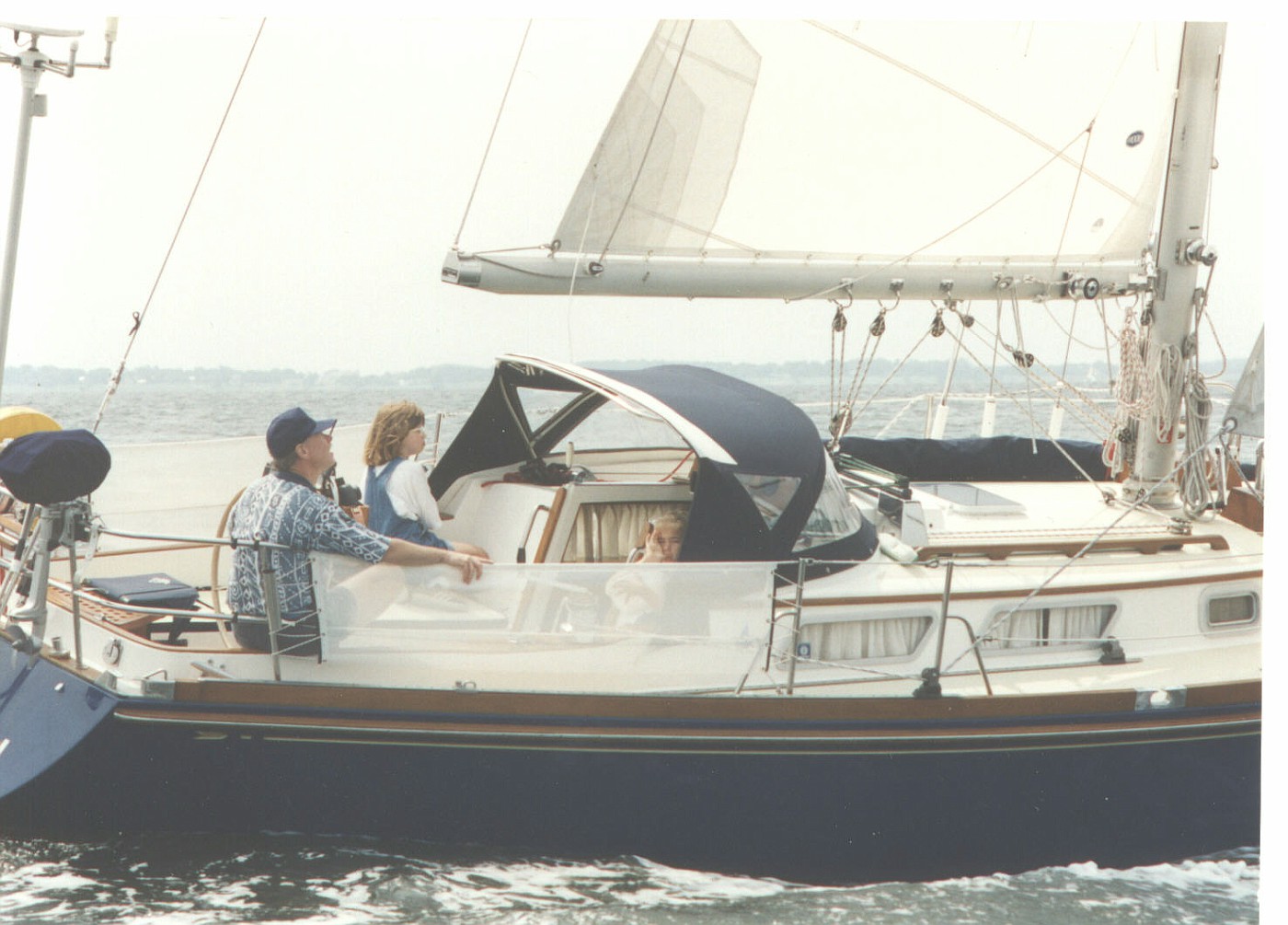
Awlgrip vs. Awlcraft and Dark Color Issues
Color scheme issues aside, before you make your selections be certain you understand the differences between Awlgrip and Awlcraft 2000, as well as the potential issues associated with switching from a light to a dark color.
I ran a boat building and refit yard for 12 years, in which we did a great deal of paint application, primarily Awlgrip. Invariably, folks wanted the snazzy dark colors, Super Jet Black, Vivid Red, Aristo Blue and Jade Mist Green. There's no doubt they looked good. And as hard as I tried to talk folks out of these colors, I was nearly always unsuccessful. Other than aesthetics, there are no advantages to dark colors unless you live in a cold climate and want the boat to warm up. Nat Herreshoff once said, "You can paint a boat any color you like, but if you paint it anything other than white you are a fool". While those aren't my sentiments exactly, he has a good point.
The disadvantages to dark colors are...
Warmer cabin and resultant additional load on HVAC (If capacity is marginal it may be too much after the color change). Increased incidence of leaks. I've measured the temp of dark colored hulls and light colored hulls side by side, white or gray 90F, black or dark blue 130F. That heating, which is nearly always uneven, creating a banana effect, leads to substantial expansion and contraction of the hull and deck, which in turn stresses bedded hardware and leads to leaks.
Perhaps of the greatest concern is post curing. When a hull that's been gray or white all its life is painted a dark color, the resin post cures, it cures more than it has cured up to that point, which causes shrinkage, which in turn can lead to a phenomenon known as print through, wherein the warp and weft of the fiberglass fabric within the laminate, or the core material blocks, becomes visible as a sort of checkerboard or weave pattern. That's very unappealing and ruins the aesthetics many folks are seeking in a dark color. There are ways to prevent it when the vessel is being built, if the builder knows it's going to be a dark hull, and there are ways to deal with it after the fact, but they are costly.
From a paint application perspective, the best Awlgrip applicator I ever had was a guy who came to the yard to cut the grass. After he cut the grass he asked if there was anything else he could do. He was put on a hull fairing project, sanding with a long board, it's arduous work to say the least, and a good test of a new employees' resolve, some quit the first day, at lunch time. This guy, however, was different; he soldiered on and eventually graduated to more skilled surface prep. Eventually he asked if he could spray Awlgrip, which was met with the same sort of response Oliver Twist received when asking for more, heck didn't he know that Awlgrip applicators are born, they don't come up from the ranks?! However, in a boat yard, spray paint trades are among the positions most difficult to fill. He was ultimately given a chance and low and behold he was a natural, a really gifted individual. After watching him for do his magic for several years I determined the secret to his success. Like celestial navigation, Awlgrip and other two part paint application is part science and part art. He was born with the art part, he could make a spray gun sing. However, he committed himself to learning the science by reading and thoroughly understanding every piece of literature produced by Akzo Nobel, the manufacturer of Awlgrip and Awlcraft. This involved surface prep, temperature, humidity, and catalyst protocols. Over the years I've seen many who were born with the skill to apply paint, but neglected to educate themselves where the science was concerned, with predictable mediocre results, which are invariably blamed on the paint. The message here is, it's all about the applicator and his or her skills and understanding of the product.
Beyond the color issue, there is a substantial difference between traditional Awlgrip and Awlcraft 2000. The former is linear polyester urethane that is extremely durable, abrasion, weather and UV resistant. It was originally developed for use on aircraft. Depending on the region, I've seen light colors last and look great for upwards of 20 years, and dark colors for 15 years. It requires exceptional skill and experience to apply and repair. Awlgrip has a thicker resin layer that gives it its durability, however, this layer prevents scratches, drips and runs from being easily buffed out while retaining long lasting shine and performance.
Awlcraft 2000 is an acrylic urethane, it was developed by Akzo Nobel to be easier to apply by less skilled applicators. It dries quicker, which reduces the likelihood of dust and insect entrapment. Because of its softer finish, a result of the less dense molecular structure, it has a lower melting point, thus when buffed, the coating can be made to flow, making repairs much easier.
Polyester molecules (Awlgrip) are much smaller than acrylic molecules (Awlcraft), which means for a given volume the polyester coating is denser, and thus more abrasion and chemical resistant, and has better color retention.
Awlgrip can be brushed, Awlcraft 2000 cannot. Both stratify, leaving a resin rich layer at the top, with a pigment rich layer beneath, which is one of the reasons they are long lasting. Awlgrip's layer is thicker than Awlcrafts, which is why it's more durable and more chemical resistant, and why it's more difficult to repair. Any buffing or repair that reduces the resin film thickness will compromise longevity and durability, as well as potentially affecting the warranty.
In order to repair a scratch for instance in Awlgrip, buffing or sanding, known as "cutting" must go deeper, penetrating the pigment layer. The resin layer is thicker and less able to flow or melt, filling the scratch or damage. Initially the repair may look shiny, however, if it's exposed the pigment and no longer has a clear coating, it will eventually dull, which means it will require regular application of Awlcare, a protective polymer coating that restores gloss, temporarily. This peculiarity of Awlgrip makes the edges of painted repair areas more difficult to blend.
Awlcraft's thinner, less dense, less cross linked, softer and more "flow-able" surface resin layer makes repairs easier. This makes it possible to carry out repairs that do not expose the pigment, because the surface resin layer melts and flows without exposing the pigment. It also makes touch up blending easier.
Even though Awlcraft 2000 is easier to repair, I've seen many repair jobs botched, primarily because unskilled or inexperienced operators use too much pressure, or to many rpm on buffing wheels, causing excessive resin melting or cutting too deeply, exposing pigment.
Today, many yards use the terms interchangeably, which is misleading. These coatings are very different animals, each with their own sets of advantages and disadvantages. If ease of repair is of the greatest importance to you, go with Awlcraft 2000, if longevity and durability is more important, and especially if you opt for a dark color, go with Awlgrip.
Above all else, vet the yard that will carry out the work carefully, among other things ask for references that include recently painted vessels as well as those that are five or more years old, preferably painted by the same painter who will lift his or her gun to your hull.
Color scheme issues aside, before you make your selections be certain you understand the differences between Awlgrip and Awlcraft 2000, as well as the potential issues associated with switching from a light to a dark color.
I ran a boat building and refit yard for 12 years, in which we did a great deal of paint application, primarily Awlgrip. Invariably, folks wanted the snazzy dark colors, Super Jet Black, Vivid Red, Aristo Blue and Jade Mist Green. There's no doubt they looked good. And as hard as I tried to talk folks out of these colors, I was nearly always unsuccessful. Other than aesthetics, there are no advantages to dark colors unless you live in a cold climate and want the boat to warm up. Nat Herreshoff once said, "You can paint a boat any color you like, but if you paint it anything other than white you are a fool". While those aren't my sentiments exactly, he has a good point.
The disadvantages to dark colors are...
Warmer cabin and resultant additional load on HVAC (If capacity is marginal it may be too much after the color change). Increased incidence of leaks. I've measured the temp of dark colored hulls and light colored hulls side by side, white or gray 90F, black or dark blue 130F. That heating, which is nearly always uneven, creating a banana effect, leads to substantial expansion and contraction of the hull and deck, which in turn stresses bedded hardware and leads to leaks.
Perhaps of the greatest concern is post curing. When a hull that's been gray or white all its life is painted a dark color, the resin post cures, it cures more than it has cured up to that point, which causes shrinkage, which in turn can lead to a phenomenon known as print through, wherein the warp and weft of the fiberglass fabric within the laminate, or the core material blocks, becomes visible as a sort of checkerboard or weave pattern. That's very unappealing and ruins the aesthetics many folks are seeking in a dark color. There are ways to prevent it when the vessel is being built, if the builder knows it's going to be a dark hull, and there are ways to deal with it after the fact, but they are costly.
From a paint application perspective, the best Awlgrip applicator I ever had was a guy who came to the yard to cut the grass. After he cut the grass he asked if there was anything else he could do. He was put on a hull fairing project, sanding with a long board, it's arduous work to say the least, and a good test of a new employees' resolve, some quit the first day, at lunch time. This guy, however, was different; he soldiered on and eventually graduated to more skilled surface prep. Eventually he asked if he could spray Awlgrip, which was met with the same sort of response Oliver Twist received when asking for more, heck didn't he know that Awlgrip applicators are born, they don't come up from the ranks?! However, in a boat yard, spray paint trades are among the positions most difficult to fill. He was ultimately given a chance and low and behold he was a natural, a really gifted individual. After watching him for do his magic for several years I determined the secret to his success. Like celestial navigation, Awlgrip and other two part paint application is part science and part art. He was born with the art part, he could make a spray gun sing. However, he committed himself to learning the science by reading and thoroughly understanding every piece of literature produced by Akzo Nobel, the manufacturer of Awlgrip and Awlcraft. This involved surface prep, temperature, humidity, and catalyst protocols. Over the years I've seen many who were born with the skill to apply paint, but neglected to educate themselves where the science was concerned, with predictable mediocre results, which are invariably blamed on the paint. The message here is, it's all about the applicator and his or her skills and understanding of the product.
Beyond the color issue, there is a substantial difference between traditional Awlgrip and Awlcraft 2000. The former is linear polyester urethane that is extremely durable, abrasion, weather and UV resistant. It was originally developed for use on aircraft. Depending on the region, I've seen light colors last and look great for upwards of 20 years, and dark colors for 15 years. It requires exceptional skill and experience to apply and repair. Awlgrip has a thicker resin layer that gives it its durability, however, this layer prevents scratches, drips and runs from being easily buffed out while retaining long lasting shine and performance.
Awlcraft 2000 is an acrylic urethane, it was developed by Akzo Nobel to be easier to apply by less skilled applicators. It dries quicker, which reduces the likelihood of dust and insect entrapment. Because of its softer finish, a result of the less dense molecular structure, it has a lower melting point, thus when buffed, the coating can be made to flow, making repairs much easier.
Polyester molecules (Awlgrip) are much smaller than acrylic molecules (Awlcraft), which means for a given volume the polyester coating is denser, and thus more abrasion and chemical resistant, and has better color retention.
Awlgrip can be brushed, Awlcraft 2000 cannot. Both stratify, leaving a resin rich layer at the top, with a pigment rich layer beneath, which is one of the reasons they are long lasting. Awlgrip's layer is thicker than Awlcrafts, which is why it's more durable and more chemical resistant, and why it's more difficult to repair. Any buffing or repair that reduces the resin film thickness will compromise longevity and durability, as well as potentially affecting the warranty.
In order to repair a scratch for instance in Awlgrip, buffing or sanding, known as "cutting" must go deeper, penetrating the pigment layer. The resin layer is thicker and less able to flow or melt, filling the scratch or damage. Initially the repair may look shiny, however, if it's exposed the pigment and no longer has a clear coating, it will eventually dull, which means it will require regular application of Awlcare, a protective polymer coating that restores gloss, temporarily. This peculiarity of Awlgrip makes the edges of painted repair areas more difficult to blend.
Awlcraft's thinner, less dense, less cross linked, softer and more "flow-able" surface resin layer makes repairs easier. This makes it possible to carry out repairs that do not expose the pigment, because the surface resin layer melts and flows without exposing the pigment. It also makes touch up blending easier.
Even though Awlcraft 2000 is easier to repair, I've seen many repair jobs botched, primarily because unskilled or inexperienced operators use too much pressure, or to many rpm on buffing wheels, causing excessive resin melting or cutting too deeply, exposing pigment.
Today, many yards use the terms interchangeably, which is misleading. These coatings are very different animals, each with their own sets of advantages and disadvantages. If ease of repair is of the greatest importance to you, go with Awlcraft 2000, if longevity and durability is more important, and especially if you opt for a dark color, go with Awlgrip.
Above all else, vet the yard that will carry out the work carefully, among other things ask for references that include recently painted vessels as well as those that are five or more years old, preferably painted by the same painter who will lift his or her gun to your hull.
Heron
Guru
- Joined
- Nov 5, 2014
- Messages
- 1,304
- Location
- USA
- Vessel Name
- Heron (2)
- Vessel Make
- '88 Cape Dory 28 Flybridge #115
I'm sure others will appreciate that info as I've already studied up. The boat will be Awlcraft BTW as mentioned earlier. I'm aware of all your other points and am confidant in my painters skill. Thanks.
Last edited:
HenryD
Senior Member
- Joined
- Dec 16, 2012
- Messages
- 477
- Location
- USA
- Vessel Name
- Seven Tenths (sold)
- Vessel Make
- Mirage / Great Harbour 47
Steve,
I have a 15yr old boat with Sky Blue Awlgrip that has several areas that need repair. I well known year in Jacksonville advised us that we needed a complete re-paint. Another yard in St.Augustine advised us that they would not paint it without two layers of primer and then the Awlgrip. Here on the west coast of FL, a yard assured us that they would fair the scratched and dings, sand the hull lightly and spray a new coat over the boat (1/3rd the cost).
What have you seen has been the repaint process for older Awlgrip boats?
ps - welcome to the Forum
I have a 15yr old boat with Sky Blue Awlgrip that has several areas that need repair. I well known year in Jacksonville advised us that we needed a complete re-paint. Another yard in St.Augustine advised us that they would not paint it without two layers of primer and then the Awlgrip. Here on the west coast of FL, a yard assured us that they would fair the scratched and dings, sand the hull lightly and spray a new coat over the boat (1/3rd the cost).
What have you seen has been the repaint process for older Awlgrip boats?
ps - welcome to the Forum
Heron
Guru
- Joined
- Nov 5, 2014
- Messages
- 1,304
- Location
- USA
- Vessel Name
- Heron (2)
- Vessel Make
- '88 Cape Dory 28 Flybridge #115
What have you seen has been the repaint process for older Awlgrip boats?
That Bristol, in my photo above suffered a serious gash down the right side in a racing "Incident". Probably 6-8 sq. feet of damaged area. Though Awlgrip and harder to section repair it was done beautifully by a skilled painter so I know it can be done. Awlcraft is easier, but Awlgrip not impossible.
Last edited:
Henry:
When it comes to painting over existing coatings yards are understandably cautious and even reluctant. Before this could be done adhesion, solvent and coating compatibility tests should be performed (the yard should be suggesting this). Detailed by Awlgrip in their instruction literature, these will determine if the existing coating is sound and well adhered to the substrate, and if it is compatible with the new paint system.
The adhesion test procedure involves scoring the paint with a razor knife and then trying to remove the coating using tape (not masking tape), while the solvent test uses a cotton ball soaked in solvent taped to the surface of the existing coating for 30 minutes, to determine if the paint has softened. The coating compatibility test involves applying Awlgrip to a small area and then testing again for adhesion after it has cured.
If these tests are passed, if I were running the yard I'd still make it clear to you that any failure between the existing coating and the substrate/primer would not be my responsible, I would only warrant adhesion of the primer and paint I apply.
In your case, repairing the damaged areas, preparing, and spraying the whole boat probably makes the most sense. While not impossible, matching 15 year old paint will be challenging, and it's approaching the end of its life in any event. Whether or not primer is needed is a judgment call, if the surface is in rough shape high build primer would be applied and then sanded to fill small imperfections.
Having said that, there are a wide range of variables that could affect that decision, in addition to the tests.
As mentioned previously, the capabilities of the yard are paramount, ask for references and inspect previous work.
When it comes to painting over existing coatings yards are understandably cautious and even reluctant. Before this could be done adhesion, solvent and coating compatibility tests should be performed (the yard should be suggesting this). Detailed by Awlgrip in their instruction literature, these will determine if the existing coating is sound and well adhered to the substrate, and if it is compatible with the new paint system.
The adhesion test procedure involves scoring the paint with a razor knife and then trying to remove the coating using tape (not masking tape), while the solvent test uses a cotton ball soaked in solvent taped to the surface of the existing coating for 30 minutes, to determine if the paint has softened. The coating compatibility test involves applying Awlgrip to a small area and then testing again for adhesion after it has cured.
If these tests are passed, if I were running the yard I'd still make it clear to you that any failure between the existing coating and the substrate/primer would not be my responsible, I would only warrant adhesion of the primer and paint I apply.
In your case, repairing the damaged areas, preparing, and spraying the whole boat probably makes the most sense. While not impossible, matching 15 year old paint will be challenging, and it's approaching the end of its life in any event. Whether or not primer is needed is a judgment call, if the surface is in rough shape high build primer would be applied and then sanded to fill small imperfections.
Having said that, there are a wide range of variables that could affect that decision, in addition to the tests.
As mentioned previously, the capabilities of the yard are paramount, ask for references and inspect previous work.
Heron
Guru
- Joined
- Nov 5, 2014
- Messages
- 1,304
- Location
- USA
- Vessel Name
- Heron (2)
- Vessel Make
- '88 Cape Dory 28 Flybridge #115
6 Month update.......Yes, the boat is still out of the water. This has been a long frustrating process. Poorly managed by the Marina, lots of wet and windy weather this spring, and then my Painter died mid project. Yup...That threw things off a bit.. Before he died he shot the color coat that had lots of drips and runs requiring sanding down almost to primer for another go. That's when things came to a shrieking halt.
Anyway, we're back on track, the Hull paint looks excellent and all that is left is to shoot the Boot and paint the bottom. As many suggested we'll carry the boot stripe over the spray rails. Hopefully we'll get this shot Monday and back in the water mid week. I SURE hope so. Here's a few shots of it masked for the boot stipe...
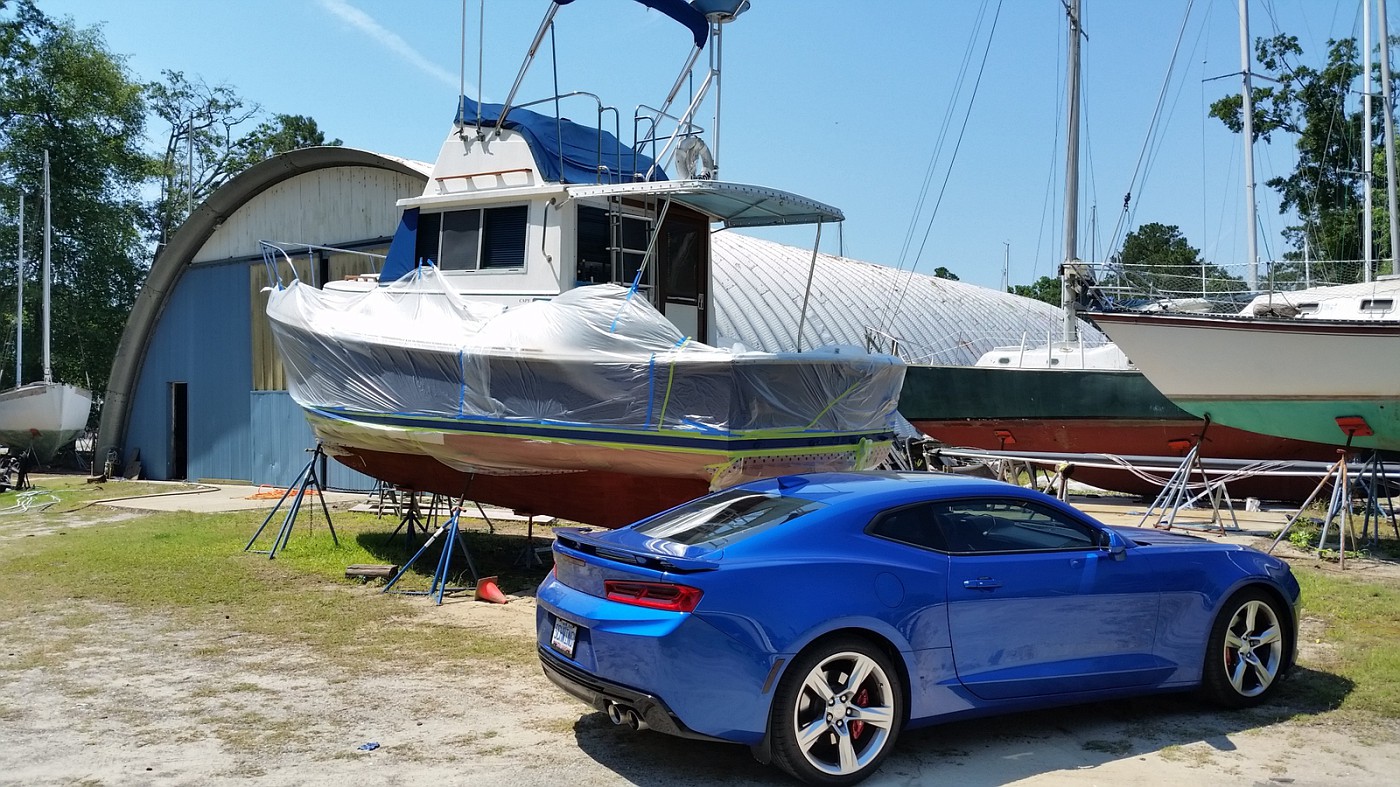
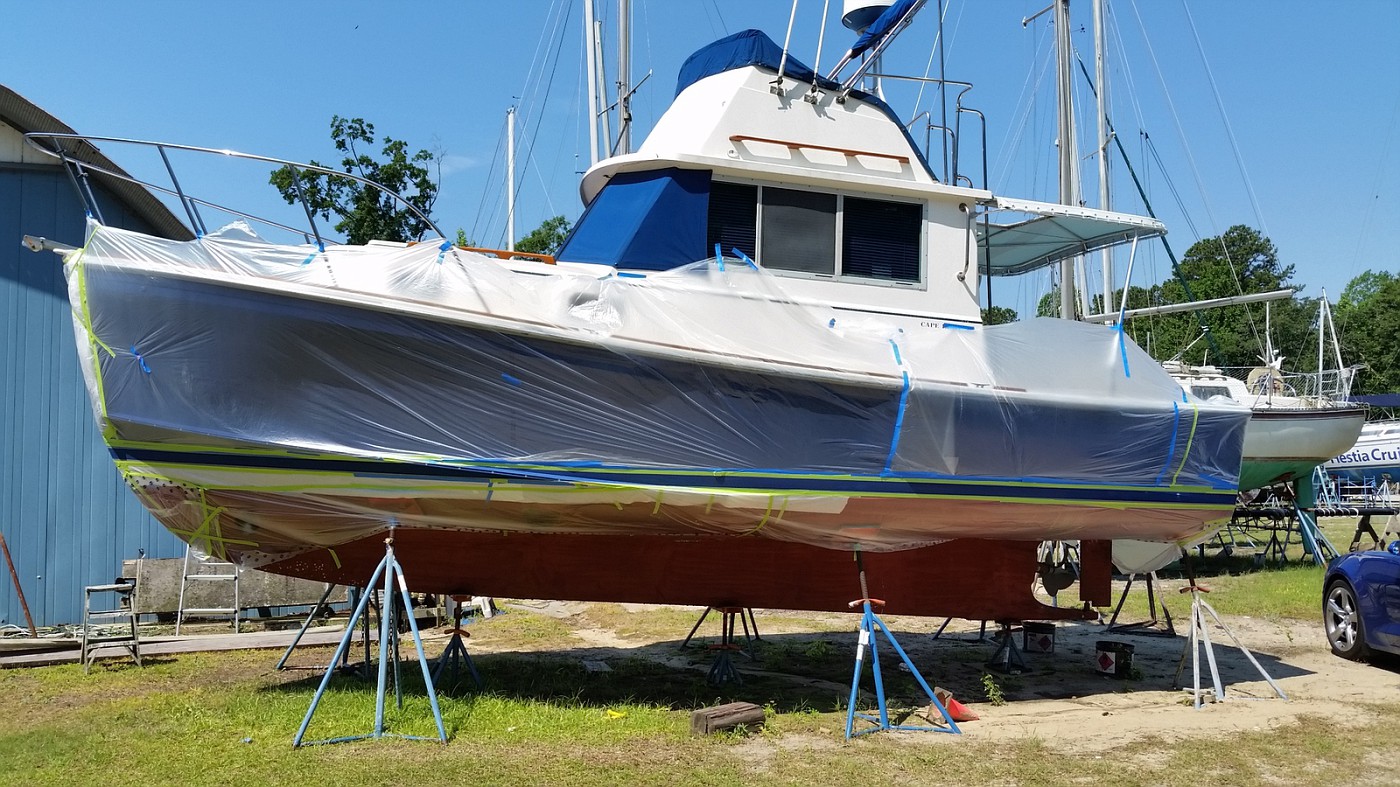
Anyway, we're back on track, the Hull paint looks excellent and all that is left is to shoot the Boot and paint the bottom. As many suggested we'll carry the boot stripe over the spray rails. Hopefully we'll get this shot Monday and back in the water mid week. I SURE hope so. Here's a few shots of it masked for the boot stipe...


Wow, I can see how'd you be a bit frustrated. Back boating by the 4th though! 

Heron
Guru
- Joined
- Nov 5, 2014
- Messages
- 1,304
- Location
- USA
- Vessel Name
- Heron (2)
- Vessel Make
- '88 Cape Dory 28 Flybridge #115
Wow, I can see how'd you be a bit frustrated. Back boating by the 4th though!
Looks like Wednesday!
Good progress since Sunday...Another coat of bottom paint tomorrow and good to go. There will be a 1" strip of blue between the Boot and Bottom. IMO looks good!
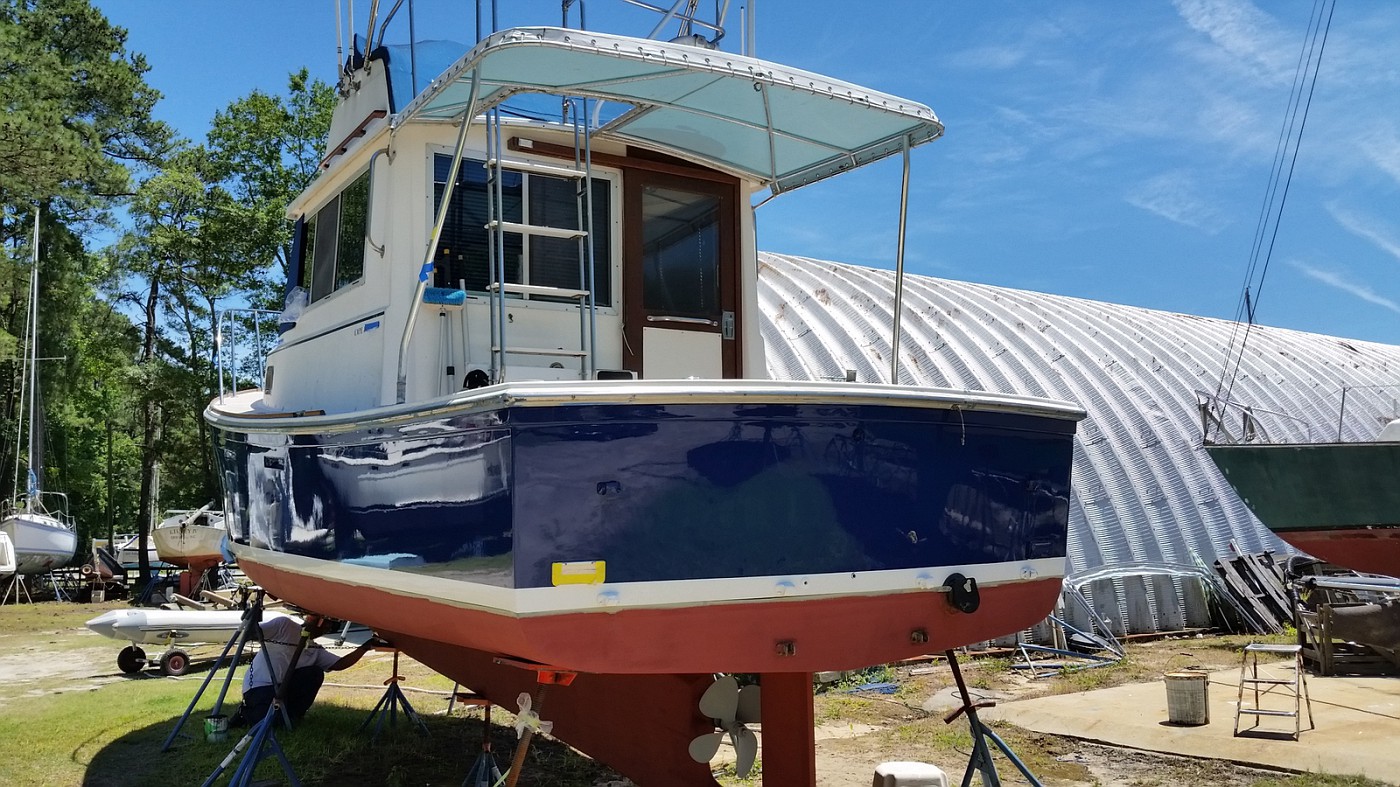
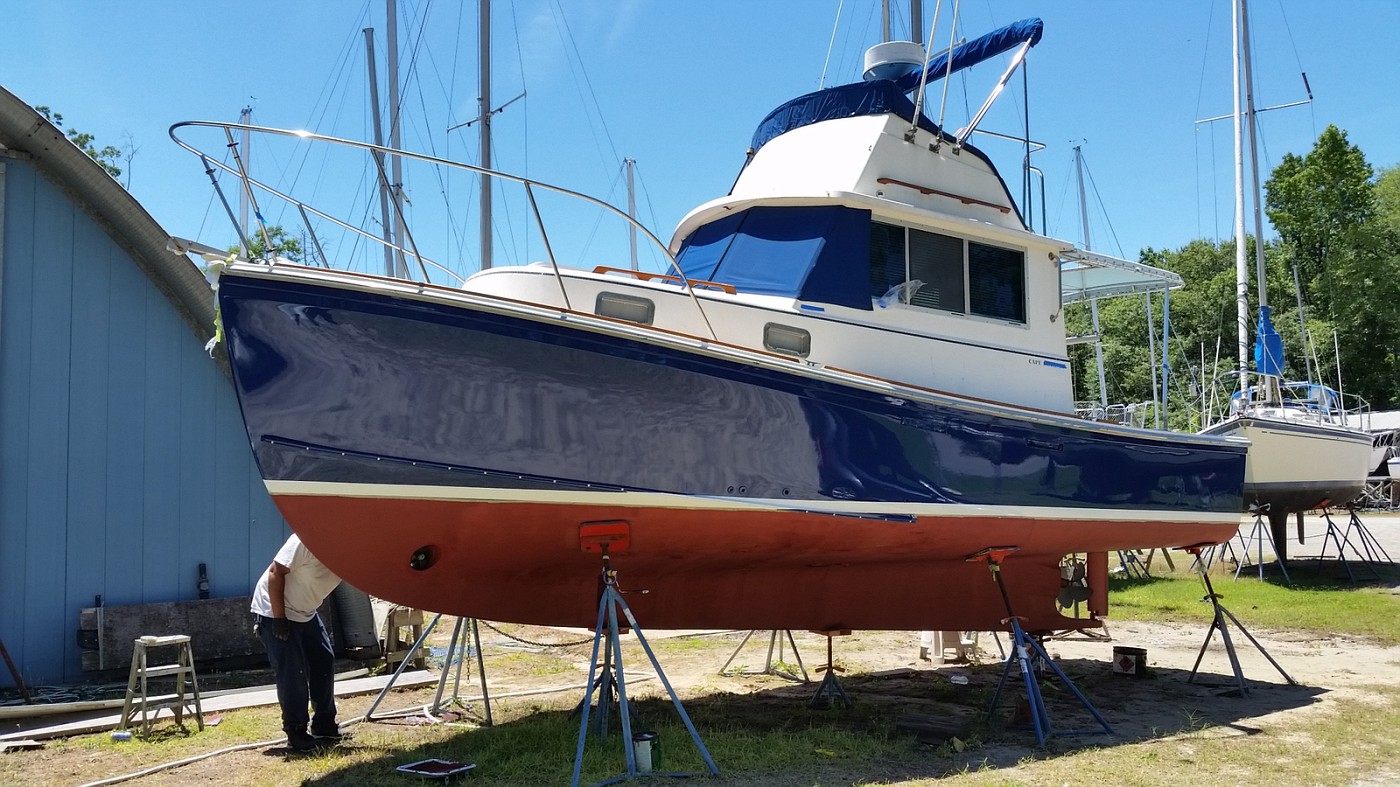
CPseudonym
Moderator Emeritus
She's purdy with her war paint on. : thumb:: thumb:
Similar threads
- Replies
- 29
- Views
- 4K
- Replies
- 21
- Views
- 4K

